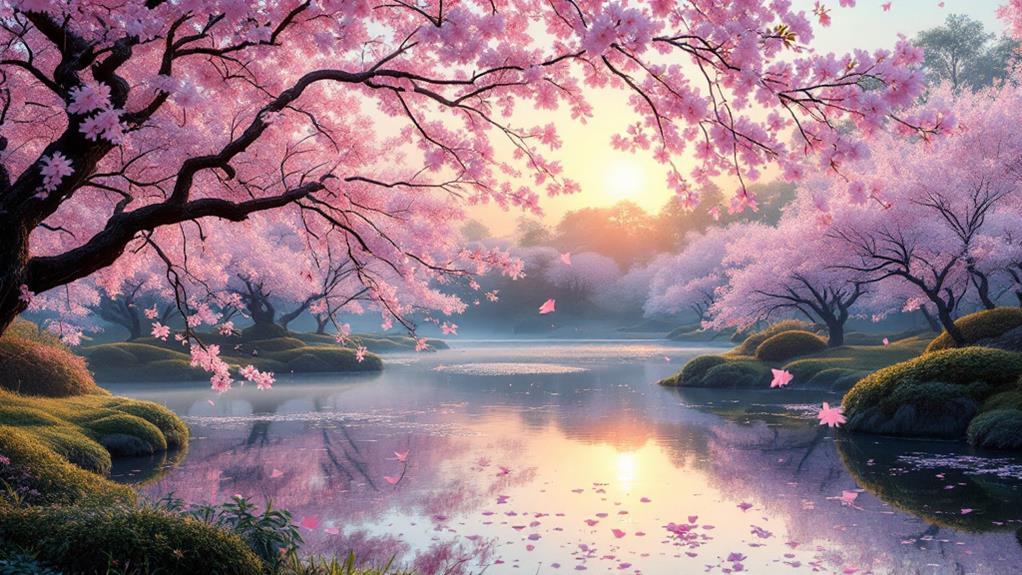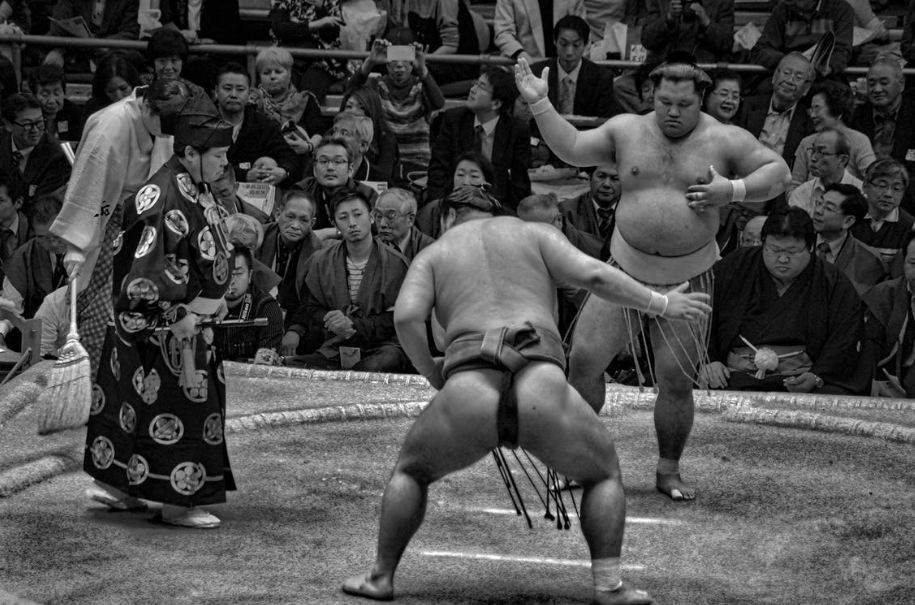What Do Cherry Blossoms Symbolize in Japanese Culture?

In Japanese culture, cherry blossoms, or sakura, embody the fleeting nature of life, reminding you of life's temporary beauty. Their brief bloom illustrates "mujo," a Buddhist concept of impermanence, prompting you to appreciate each moment. Historically, sakura herald spring's arrival and were once an elite pastime but now unite communities during hanami, a joyful celebration under the blossoms. They inspire a range of art, literature, and fashion, emphasizing renewal and the elegance of transience. Cherry blossoms are more than beautiful flowers; they're a lively symbol of life's cycles, encouraging reflection and gratitude for the present. There's more to investigate.
Historical Significance of Cherry Blossoms
Throughout history, cherry blossoms have held a special place in Japanese culture, symbolizing the fleeting beauty of life. When you investigate their historical significance, you'll find that these blossoms, known as "sakura," are deeply rooted in Japan's cultural heritage. Dating back to the Nara Period (710-794), cherry blossoms have marked the arrival of spring, a time of renewal and reflection. They've always been more than just beautiful flowers; they're a reminder of nature's transient nature and the importance of living in the moment. Likewise, patterns and motifs in kimono designs often convey virtues and cultural beliefs, reflecting the changing seasons and the ephemeral beauty of nature. In ancient times, cherry blossom viewing, or "hanami," was a practice reserved for the elite. Over the centuries, it became a cherished tradition for all Japanese people, showcasing the country's appreciation for seasonal beauty. As you investigate this tradition, you'll see how sakura festivals today continue to unite communities, offering a time for celebration and contemplation. The blossoms' brief yet glorious bloom embodies the essence of Japanese aesthetics, influencing everything from poetry to public celebrations. By understanding cherry blossoms' historical role, you gain insight into how they've shaped and enriched Japan's cultural identity over time.
Symbolism in Japanese Art

In Japanese art, rich symbolism interweaves with aesthetic expression, offering profound insights into cultural values and beliefs. When you investigate artworks featuring cherry blossoms, you'll notice how these flowers embody the fleeting nature of life. Artists often capture their ephemeral beauty, celebrating aesthetic appreciation and seasonal beauty. By doing so, they invite you to reflect on the transient moments in your own life and the importance of cherishing them. This transient nature can also be paralleled with modern transformations in Japanese family structures, where traditions adapt to contemporary societal changes.
Cherry blossoms, or sakura, frequently appear in paintings, woodblock prints, and ceramics. In these works, you can see how artists use delicate brushstrokes and lively colors to evoke the blossoms' short-lived splendor. This artistic approach not only highlights the flowers' beauty but also symbolizes renewal and the cyclical nature of the seasons. As you engage with these pieces, you gain a deeper understanding of the cultural significance of embracing change and the passage of time.
Moreover, cherry blossoms in art serve as a reminder of nature's influence on human emotions and experiences. By appreciating these artistic representations, you connect with the broader themes of life's impermanence and the enduring beauty that each season brings.
Connection to Buddhist Philosophy

Exploring the connection to Buddhist philosophy, cherry blossoms elegantly illustrate the concept of impermanence, or "mujo," a fundamental tenet in Buddhism. As you observe these delicate blooms, you're reminded of life's transient nature. Their brief, breathtaking appearance each spring captures the essence of Buddhist impermanence, prompting reflection on how life, like cherry blossoms, is both stunning and fleeting. This perspective encourages you to appreciate the present moment and find beauty in the temporary.
Cherry blossoms serve as a poignant reminder that nature's beauty is transient. They bloom brilliantly for just a short period, reminding you that nothing lasts forever. This mirrors the Buddhist teaching that everything is in a constant state of change. By embracing this idea, you're invited to focus on the present and cultivate a sense of gratitude for the beauty and experiences life offers, no matter how brief.
In Buddhist teachings, cherry blossoms become a metaphor for the cycle of life and the acceptance of change. When you reflect on their symbolism, you're encouraged to let go of attachments and accept life's impermanent nature, finding peace and joy in every moment.
Role in Hanami Celebrations

Cherry blossoms don't just symbolize impermanence; they're also fundamental to the lively tradition of hanami celebrations in Japan. During these cherry blossom festivals, you're invited to welcome the fleeting beauty of nature by gathering with friends and family under the blooming trees. This seasonal tradition dates back centuries and remains a crucial part of Japanese culture. You'll find parks and riversides filled with people enjoying picnics, music, and laughter, all under a canopy of pink and white blossoms.
When you participate in hanami, you're not just observing the beautiful blossoms; you're partaking in a cultural ritual that signifies renewal and the transient nature of life. It's an opportunity to pause, reflect, and appreciate the moment. Cherry blossom festivals provide a backdrop for creating memories, fostering connections, and celebrating the arrival of spring. As you lay your picnic blanket beneath the cherry trees, you'll likely encounter others doing the same, illustrating the communal aspect of this beloved seasonal tradition.
Whether you're a local or a visitor, joining in hanami celebrations offers a unique glimpse into Japan's cultural heart. It's an experience that captures both the joy and poignancy of cherry blossoms in full bloom.
Cherry Blossoms in Literature

One of the most enduring symbols in Japanese literature is the cherry blossom, often representing the beauty and impermanence of life. As you investigate Japanese texts, you'll find cherry blossoms woven into narratives and poetry, reflecting the fleeting nature of existence. Cherry blossom poetry, known as "sakura poetry," captures the delicate balance between life's lively moments and their inevitable end. This seasonal imagery not only highlights the blossom's transient beauty but also mirrors human experiences.
Consider the following ways cherry blossoms appear in literature:
- Ephemeral Beauty: Writers use cherry blossoms to illustrate moments of stunning beauty that are short-lived, reminding you to cherish each moment.
- Cycle of Life: The blossoms' annual bloom and inevitable fall symbolize life's cyclical nature, encouraging reflection and acceptance of change.
- Emotional Depth: Cherry blossoms evoke deep emotions, often used to express longing, nostalgia, or the bittersweet passage of time.
- Cultural Identity: They serve as a symbol of national identity, reflecting Japan's deep connection to nature and tradition.
Through these literary elements, cherry blossoms invite you to appreciate life's temporary beauty and welcome the changes it brings, enriching your understanding of Japanese culture.
Influence on Japanese Fashion

Just as cherry blossoms enrich Japanese literature with their symbolic depth, they also leave a profound mark on Japanese fashion. You'll notice sakura patterns adorning everything from traditional kimonos to modern streetwear, capturing the transient beauty of cherry blossoms. These patterns often appear during spring, aligning with the cherry blossom season, when the demand for seasonal attire peaks. The gentle pink hues and delicate designs evoke a sense of renewal and hope, echoing the cultural significance of sakura as a symbol of life's fleeting nature.
Incorporating cherry blossoms into fashion isn't just about aesthetics; it's also about embracing a deep cultural resonance. When you wear sakura patterns, you're participating in a tradition that celebrates the Japanese appreciation for nature's beauty and the impermanence of life. It's common to see these motifs in accessories too, like scarves and handbags, adding a touch of elegance to any outfit.
Moreover, the influence of sakura extends beyond clothing. You'll find cherry blossom-inspired jewelry and hair accessories, allowing you to carry a piece of this iconic symbol with you, creating a harmonious blend of style and tradition in your wardrobe.
Modern Interpretations and Meanings

How have cherry blossoms evolved in their cultural significance today? In modern times, cherry blossoms continue to hold a special place in Japanese culture, but their meanings have expanded beyond traditional views. They now reflect contemporary ideals and global connections. The fleeting beauty of cherry blossoms resonates with people worldwide, reminding you of the temporary nature of life and the importance of appreciating the moment. In Japan, cherry blossoms have become a symbol of national pride and cultural identity, celebrating the country's rich heritage and natural beauty.
Modern interpretations highlight how cherry blossoms serve as a metaphor for:
- Seasonal change: They mark the shift from winter to spring, symbolizing renewal and new beginnings.
- Unity and community: People gather for hanami parties, fostering social bonds and shared experiences.
- Environmental awareness: Blossoms remind you of nature's cycles and the need for conservation.
- Global connections: As cherry blossoms are celebrated worldwide, they bridge cultural divides and promote international understanding.
Incorporating cherry blossoms into modern art, design, and media also underscores their evolving significance. From tattoos to digital art, these blossoms continue to inspire creativity and reflect contemporary values, while still honoring their deep-rooted symbolism in Japanese culture.



